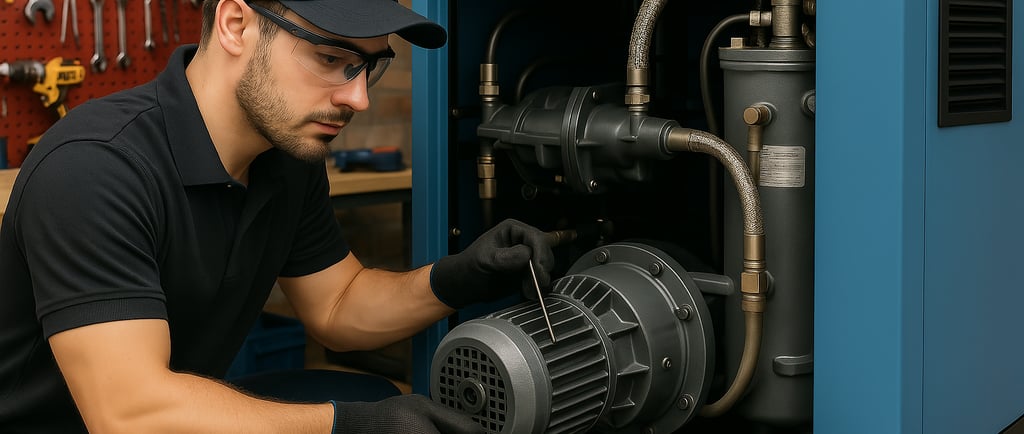Essential Screw Air Compressor Maintenance Tips for the Rainy Season
Rainy weather presents unique challenges for businesses relying on screw air compressors. Increased humidity, water ingress, and stormy conditions can threaten your equipment’s reliability, efficiency, and lifespan. By adjusting your maintenance routine for wet weather, you can keep your compressor running flawlessly and avoid costly downtime.
Shreekalp Team
7/26/20252 min read


Rain’s Impact on Screw Compressors
1. Moisture Buildup:
Humid air during rainy days brings extra moisture into your compressor. This moisture increases condensation, promoting rust, oil contamination, and issues in downstream processes.
2. Electrical Hazards:
Rain and standing water raise the risk of electrical shorts. Without proper precautions, sensitive components become vulnerable to failures and safety hazards.
3. Overheating Risks:
Wet debris can block coolers, causing poor heat dissipation and increasing the chance of overheating.
Rainy Weather Maintenance Checklist
1. Ensure Proper Shelter
Move the compressor indoors, if not, or install a protective cover to shield it from direct rain. Keep ventilation louvres above ground level, and add screens to stop debris from being drawn in.
2. Strengthen Electrical Safety
Confirm the compressor frame is properly grounded and protected by a GFCI breaker. Inspect all electrical inlets, reseal any gaps, and replace worn grommets to stop water from creeping into your electrics.
3. Step Up Drainage Management
Switch any manual condensate drains to automatic traps and inspect them with every shift change. Water buildup is more common during the rainy months, so check and drain low points like airend and separator tanks more frequently. Click here to buy drain valve.
4. Monitor Dryers and Filters
Monitor dew point daily—any sustained rise can signal an overloaded dryer or spent desiccant. Replace filter elements more often as they clog quickly with damp dust.
5. Keep a Close Eye on Oil
Check the oil sight glass regularly. A milky appearance means water contamination—drain and replace the oil and separator right away to avoid rotor damage.
6. Clean Coolers and Airflow Paths
Clear out coolers and vents at least weekly. Wet debris quickly reduces cooling efficiency, increasing the risk of shutdowns.
7. Inspect for Rust and Leaks
Look for signs of rust on tanks and fittings, and be alert for new hissing air leaks—water accelerates seal wear and may waste significant energy.
Daily Quick-Check Log (During Rainy Season)
Record dew point readings.
Inspect oil for water contamination.
Confirm automatic drains are functioning.
Clean cooler fins.
Final Thought
The rainy season demands extra vigilance, but a proactive approach ensures your screw air compressor remains dry, reliable, and efficient. Adopt these strategies, and you’ll weather even the wettest months with confidence and minimal downtime.
Location
Old Mumbai Pune Road,
Shil, Thane, MH, India- 400612
Contact
+91 9892134481
support@shreekalp.com
Shreekalp Engineering
GSTIN: 27AONPA5936J1ZN
